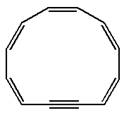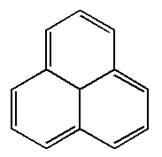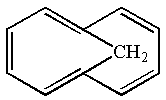
Concept explainers
(a)
Interpretation:
Whether the given molecule is
Concept introduction:
The molecules, to be aromatic, must obey Hückel’s rule of
Answer to Problem 14.41P
The given molecule is nonaromatic due to lack of planarity.
Explanation of Solution
The given structure is:

The molecule has total
The molecule is determined as nonaromatic based on the structure planarity.
(b)
Interpretation:
Whether the given molecule is aromatic, antiaromatic, or nonaromatic, is to be determined.
Concept introduction:
The molecules, to be an aromatic, must obey Hückel’s rule of
Answer to Problem 14.41P
The given molecule is nonaromatic due to lack of planarity.
Explanation of Solution
The given structure is:

The molecule has total
The molecule is determined as nonaromatic based on the structure planarity.
(c)
Interpretation:
Whether the given molecule is aromatic, antiaromatic, or nonaromatic, is to be determined.
Concept introduction:
The molecules, to be an aromatic, must obey Hückel’s rule of
Answer to Problem 14.41P
The given molecule is aromatic as it is planar, has cyclic conjugation, and obeys Hückel’s rule.
Explanation of Solution
The given structure is:

The given molecule is planar and has total
The molecule is determined as aromatic based on the Hückel’s rule.
(d)
Interpretation:
Whether the given molecule is aromatic, antiaromatic, or nonaromatic, is to be determined.
Concept introduction:
The molecules, to be an aromatic, must obey Hückel’s rule of
Answer to Problem 14.41P
The given molecule is nonaromatic due non cyclic conjugated system.
Explanation of Solution
The given structure is:
![]()
The molecule has a conjugated system of total
The molecule is determined as nonaromatic based on the non cyclic structure which lacks cyclic conjugation.
(e)
Interpretation:
Whether the given molecule is aromatic, antiaromatic, or nonaromatic, is to be determined.
Concept introduction:
The molecules, to be an aromatic, must obey Hückel’s rule of
Answer to Problem 14.41P
The given molecule is aromatic as it is planar, has cyclic conjugation, and obeys Hückel’s rule.
Explanation of Solution
The given structure is:

The molecule is planar and has fully cyclic conjugated system of total
The molecule is determined as aromatic based on planarity, fully conjugated system, and having Hückel’s rule of
(f)
Interpretation:
Whether the given molecule is aromatic, antiaromatic, or nonaromatic, is to be determined.
Concept introduction:
The molecules, to be an aromatic, must obey Hückel’s rule of
Answer to Problem 14.41P
The given molecule is nonaromatic as it is not conjugated and does not obey Hückel’s rule.
Explanation of Solution
The given structure is:

The molecule has only
The molecule is determined as nonaromatic based on the non-conjugated system of
(g)
Interpretation:
Whether the given molecule is aromatic, antiaromatic, or nonaromatic, is to be determined.
Concept introduction:
The molecules, to be an aromatic, must obey Hückel’s rule of
Answer to Problem 14.41P
The given molecule is nonaromatic as it has no cyclic conjugated system.
Explanation of Solution
The given structure is:

One of the lone pair on the oxygen atom participates in the resonance, thus, the molecule has
The molecule is determined as nonaromatic based on non-conjugated system of
Want to see more full solutions like this?
Chapter 14 Solutions
Organic Chemistry: Principles and Mechanisms (Second Edition)
- Draw a mental model for calcium chloride mixed with sodium phosphatearrow_forwardhere is my question (problem number 20) please explain to me thanks!arrow_forwardThe bromination of anisole is an extremely fast reaction. Complete the resonance structures of the intermediate arenium cation for the reaction (Part 1), and then answer the question that follows (Part 2).arrow_forward
- Drawing of 3-fluro-2methylphenolarrow_forwardWhich compound(s) will be fully deprotonated (>99%) by reaction with one molar equivalent of sodium hydroxide? I, II, III I, || I, III I only II, III SH | H3C-C=C-H || III NH2arrow_forwardWill NBS (and heat or light) work for this reaction, or do we have to use Br2?arrow_forward
- HAND DRAWarrow_forwardPredict the major products of the following organic reaction: Some important notes: Δ CN ? • Draw the major product, or products, of the reaction in the drawing area below. • If there aren't any products, because no reaction will take place, check the box below the drawing area instead. Be sure to use wedge and dash bonds when necessary, for example to distinguish between major products that are enantiomers. ONO reaction. Click and drag to start drawing a structure.arrow_forwardThe following product was made from diethyl ketone and what other reagent(s)? £ HO 10 2-pentyne 1-butyne and NaNH2 ☐ 1-propanol ☐ pyridine butanal ☐ pentanoatearrow_forward
- Which pair of reagents will form the given product? OH X + Y a. CH3 b. CH2CH3 ༧་་ C. CH3- CH2CH3 d.o6.(རི॰ e. CH3 OCH2CH3 -MgBr f. CH3-MgBr g. CH3CH2-MgBr -C-CH3 CH2CH3arrow_forwardQuestion 3 What best describes the product of the following reaction? 1. CH3CH2MgBr (2 eq) 2. H a new stereocenter will not be formed a new stereocenter will be formed an alkyl halide will result an alkane will result an aromatic compound will result 1 ptsarrow_forwardRank the following from most to least reactive toward nucleophilic attack. 1. [Select] [Select] 2. Acyl halide Aldehyde 3. Carboxylate ion 4. Carboxylic acid Ketone 5. [Select]arrow_forward
 Organic Chemistry: A Guided InquiryChemistryISBN:9780618974122Author:Andrei StraumanisPublisher:Cengage Learning
Organic Chemistry: A Guided InquiryChemistryISBN:9780618974122Author:Andrei StraumanisPublisher:Cengage Learning

